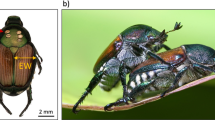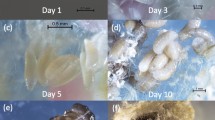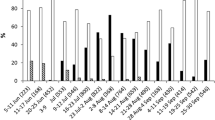Abstract
The most harmful hymenopteran pests of Pinus sylvestris L. are conifer sawflies from the family Diprionidae, including the widespread Diprion pini (L.). Natural enemies of this pest are still poorly known in many European areas where attacks occur. We studied the egg parasitoids of D. pini at four sites in two mountainous areas of Spain: the Sierra de Francia (western Spain) and the Sierra de Albarracín (eastern Spain). At all sites, the dominant egg parasitoid was Neochrysocharis formosa (Westwood) (Hymenoptera: Eulophidae), whereas other three chalcidoid species were rare. All these species were previously recorded in association with D. pini, but we report here their first record in Spain. Neochrysocharis formosa attacked up to 32.3% of egg clusters of D. pini in the Sierra de Albarracín and 18.5% in the Sierra de Francia. In the attacked egg clusters, this species parasitized up to 35% of eggs in the Sierra de Albarracín and 23.7% in the Sierra de Francia, with a marked female-biased sex ratio. Contrary to the clustered pattern of parasitism observed for N. formosa while attacking other gregarious diprionids, the oviposition in egg clusters of D. pini followed a random pattern, probably due to the froth roof (spumous coating) that covers its eggs and interferes with the egg-searching behavior of females. Indeed, other parasitoid species of D. pini have been reported to behave similarly.

Similar content being viewed by others
References
Adachi-Hagimori, T., Miura, K., & Abe, Y. (2011). Gene flow between sexual and asexual strains of parasitic wasps: a possible case of sympatric speciation caused by a parthenogenesis-inducing bacterium. Journal of Evolutionary Biology, 24, 1254–1262.
Askew, R. R. (1979). Taxonomy of some European Chrysonotomyia Ashmead (Hymenoptera: Eulophidae) with description of C. longiventris n.sp. and notes on distribution. Entomologica Scandinavica, 10, 27–31.
Ceballos, G., & Zarco, E. (1952). Ensayo de lucha biológica contra una plaga de Diprion pini en masas de Pinus sylvestris de la Sierra de Albarracín. Madrid: Instituto Español de Entomología.
Çikman, E., Beyarslan, A., & Civelek, H. S. (2006). Parasitoids of leafminers (Diptera: Agromyzidae) from Southeast Turkey with 3 new records. Turkish Journal of Zoology, 30, 167–173.
Dajoz, R. (2001). Entomología Forestal: los insectos y el bosque. Madrid: Ediciones Mundi-Prensa.
Dusaussoy, G., & Geri, C. (1971). Étude des populations résiduelles de Diprion pini L. à Fontainebleau après la gradation de 1963-1964. Annals of Forest Science, 28, 297–322.
Eichhorn, O., & Pschorn-Walcher, H. (1976). Studies on the biology and ecology of the egg-parasites (Hm.: Chalcidoidea) of the pine sawfly Diprion pini (L.) (Hm.: Diprionidae) in Central Europe. Zeitschrift für Angewandte Entomologie-Journal of Applied Entomology, 80, 355–381.
Elekçioğlu, N. Z., & Uygun, N. (2006). The parasitoids complex of the citrus leafminer, Phyllocnistis citrella Stainton (Lepidoptera: Gracillariidae) in the East Mediterranean region of Turkey and their role in biological control. Turkish Journal of Zoology, 30, 155–160.
Fisher, N., & La Salle, J. (2005). A new species of Neochrysocharis Kurdjumov (Hymenoptera: Eulophidae), a parasitoid of serpentine leafminers (Diptera: Agromyzidae) in Southeast Asia. Zootaxa, 1044, 27–34.
Gençer, L., & Seven, S. (2005). Chalcidoid parasitoids of Micrurapteryx sophorivora (Lepidoptera: Gracillariidae) in Kuluncak, Turkey. Phytoprotection, 86, 133–134.
Geri, C., & Dusaussoy, G. (1966). Étude d’une population de Diprion pini (Hym., Symphytes) en forêt de Fontainebleau. II. Etablissement d’une table de mortalité. Annales de la Société Entomologique de France (N.S.), 2, 535–548.
Hagimori, T., Abe, Y., Date, S., & Miura, K. (2006). The first finding of a Rickettsia bacterium associated with parthenogenesis induction among insects. Current Microbiology, 52, 97–101.
Hansson, C. (1990). A taxonomic study on the Palearctic species of Chrysonotomyia Ashmead and Neochrysocharis Kurdjumov (Hymenoptera: Eulophidae). Entomologica Scandinavica, 20, 29–52.
Leather, S. R., & Watt, A. D. (2005). Sampling theory and practice: Methods in ecology. In S. Leather (Ed.), Insect sampling in forest ecosystems (pp. 1–15). Victoria: Blackwell Science Ltd.
Muñoz-López, C., Pérez-Fortea, V., Cobos-Suárez, P., Hernández-Alonso, R., & Sánchez Peña, G. (2003). Sanidad Forestal. Guía en imágenes de plagas, enfermedades y otros agentes presentes en los bosques. Madrid: Ediciones Mundi-Prensa.
Noyes, J.S. (2016). Universal Chalcidoidea Database. World Wide Web electronic publication. http://www.nhm.ac.uk/chalcidoids. Accessed on 5 August 2016.
Pschorn-Walcher, H., & Eichhorn, O. (1973). Studies on the biology and ecology of the egg parasites (Hym: Chalcidoidea) of the pine sawfly Neodiprion sertifer (Geoff) (Hym.: Diprionidae) in central Europe. Zeitschrift für Angewandte Entomologie-Journal of Applied Entomology, 74, 286–318.
Romanyk, D., & Cadahía, D. (2003). Plagas de insectos en las masas forestales españolas (4ªth ed.). Madrid: Ministerio de Medio Ambiente.
Ryvkin, B. V. (1963). Zur Kenntnis der Biologie von Kiefernblattwespen in Bjelorußland. Beiträge zur Entomologie-Contributions to Entomology, 13, 455–464.
Schwenke, W. (1963). Erfolgreiche Versuche zur biologischen Bekämpfung der Forstschädlinge Diprion pini L. (Hymen., Tenthr.) und Panolis flammea Schiff. (Lepid., Noct.) vermittels Chalcididen (Hymen.). Zeitschrift für Angewandte Entomologie-Journal of Applied Entomology, 53, 178–186.
Southwood, T. E., & Henderson, P. A. (2000). Ecological methods. Oxford: Blackwell Science.
Vélez, L., Díez, J. J., & Pajares, J. A. (2001). Biología de Diprion pini en la Sierra de Francia. Granada: III Congreso Forestal Español, Libro de Actas, Mesa 6, pp. 45–51.
Zappalà, L., Bernardo, U., Biondi, A., Cocco, A., Deliperi, S., Delrio, G., Giorgini, M., Pedata, P., Rapisarda, C., Tropea Garzia, G., & Siscaro, G. (2012). Recruitment of native parasitoids by the exotic pest Tuta absoluta in Southern Italy. Bulletin of Insectology, 65, 51–61.
Acknowledgements
This study was carried out in the laboratories of the Faculties of Biology of Salamanca and Valencia, as well as at the Museu Valencià d’Historia Natural and at the Instituto Valenciano de Investigaciones Agrarias in Valencia. We are indebted to José Ramón Oriola (Ministry of Agriculture, Government of Valencia) for his collaboration in the sampling and fieldwork. We are also indebted to María Jesús Verdú Gallardo (InstitutoValenciano de Investigaciones Agrarias, Valencia, Spain) and Severiano Fernández Gayubo (Universidad de Salamanca, Salamanca, Spain), for corroboration of the determinations of the parasitoids and hosts, respectively. Financial support for this study was provided by the Junta de Castilla y León, project SA012A05, and by a post-doctoral contract to CP from Universidad de Castilla-La Mancha. The experiments complied with Spanish law currently in force.
Author information
Authors and Affiliations
Corresponding author
Rights and permissions
About this article
Cite this article
Selfa, J., Polidori, C., Asís, J.D. et al. Random pattern of parasitism and female-biased sex ratio in the egg parasitoid Neochrysocharis formosa attacking the pine sawfly Diprion pini in mountain forests of Spain. Phytoparasitica 45, 85–93 (2017). https://doi.org/10.1007/s12600-017-0568-z
Received:
Accepted:
Published:
Issue Date:
DOI: https://doi.org/10.1007/s12600-017-0568-z




